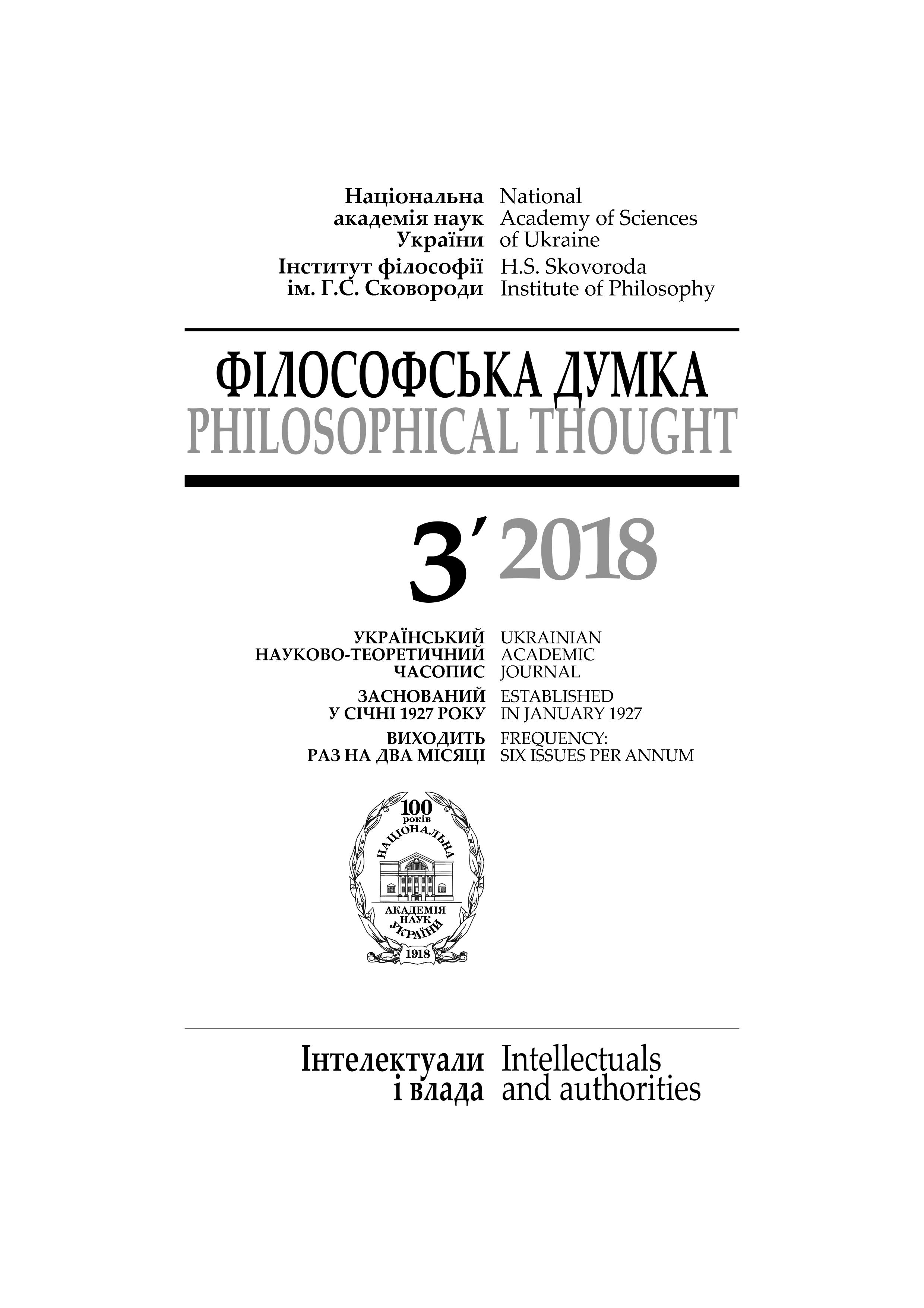Два типи моральних рішень
СОЦІАЛЬНА ФІЛОСОФІЯ
Ключові слова:
моральне рішення, моральна інтуїція, моральне міркування, двосистемний підхід, двопроцесна теорія моральних судженьАнотація
У статті проаналізовано та здійснено класифікацію головних різновидів моральних рішень. Засадовими для класифікації є два типи моральних рішень, які відповіда- ють двом типам когнітивних процесів, описаних Д. Канеманом (Система 1 та Система 2). Поділяючи критичні зауваження Дж. Еванс та К. Станович щодо термі- нів «Система 1» та «Система 2», ми пропонуємо вести мову про перший та другий типи процесів прийняття моральних рішень, результатом яких, у свою чергу, є мо- ральні рішення першого та другого типів. До першого (інтуїтивного) типу належать автоматичні, швидкі, прийнятті в режимі мінімальних зусиль та контролю моральні рішення. До другого типу належать моральні рішення, яким передують цілеспрямо- вані міркування індивіда. Головними різновидами моральних рішень першого типу є: 1) інтуїтивно-емоційні моральні рішення, тобто рішення, прийняті під впливом емоцій, які супроводжують процес прийняття моральних рішень (наприклад, емпа- тії, сорому, довіри, турботи, відрази); 2) інтуїтивно-нормативні моральні рішення, тобто рішення, прийняті під впливом засвоєних до автоматизму соціокультурних норм; 3) рішення, прийняті під впливом морально-ризикових психологічних схиль- ностей (це схильності (упередження, соціальні евристики тощо), які, не усвідомлю- ючись людиною, примушують її міркувати у певному напрямку та приймати рішен- ня, які інколи є неприйнятними з точки зору логіки та етики). Моральні рішення першого типу є готовими рішеннями, які були сформовані у процесі біосоціокуль- турної еволюції чи індивідуального досвіду особи. Сприймаючи сигнали середови- ща, мозок людини несвідомо співвідносить їх з тими відповідями, які має, і, знай- шовши відповідність, автоматично та швидко пропонує готове рішення. Різновидами моральних рішень другого типу є: 1) раціоналізовані моральні рішення (раціона- лізацією у цьому випадку є міркування, що мають місце після інтуїтивної реакції та покликані виправдати, обґрунтувати, прояснити її перед остаточним рішенням); 2) раціональні моральні рішення — рішення, засадовими для яких є свідомо обрані моральні правило, принцип чи норма.
Посилання
Nadurak, V. (2016). Emotions and Considerations in Taking Moral Decisions. [In Ukrainian]. Antropologichni vymiry filosofskykh doslidzhen, 10, pp. 24-32. [ = Надурак 2016]
Nadurak, V. (2017). Critical Analysis of Reliability of Intuitive Moral Decisions [In Ukrainian]. Antropologichni vymiry filosofskykh doslidzhen, 11, pp. 7-15. [ = Надурак 2017]
Bartels, D.M., Bauman, C.W., Cushman, F.A., Pizarro, D,A., McGraw, A.P. (2015). Moral Judgment and Decision Making. In: The Wiley Blackwell Handbook of Judgment and De- cision Making (pp. 479-516). Chichester, West Sussex: Wiley-Blackwell.
Borry, P., Schotsmans, P., Dierickx, K. (2004). Editorial. Empirical ethics: A challenge to bio- ethics. In: Medicine, Health Care and Philosophy, 7 (1), 1-3.
Evans,J.St.B.T.,Stanovich,K.E.(2013).Dual-ProcessTheoriesofHigherCognition:Advancing the Debate. In: Perspectives on Psychological Science, 8 (3), 223-241.
Gigerenzer, G. (2008). Moral Intuition = Fast and Frugal Heuristics? In: Moral Psychology. Vol. 2: The Cognitive Science of Morality: Intuition and Diversity (pp. 1-26). S.l.: MIT Press.
Gigerenzer, G. (2008). Reply to Comments. In:Moral Psychology, Vol. 2: The Cognitive Science of Morality: Intuition and Diversity (pp. 41-66). S.l.: MIT Press.
Greene, J.D. (2014). Beyond Point-and-Shoot Morality: Why Cognitive (Neuro) Science Mat- ters for Ethics. In: Ethics,24 (4), 695-726.
G r ay, B., Baron, J. (2017). Challenges for the sequential two-system model of moral judge- ment. In: Thinking & Reasoning, 23 (1). DOI: http://dx.doi.org/10.1080/13546783.2016.1 216011.
Haidt, J. (2001). The emotional dog and its rational tail: A social intuitionist approach to moral judgment. In: Psychological Review, 108 (4), 814-834.
Haidt, J., Kesebir, S. (2010). Morality. In: Handbook of Social Psychology (vol. 2, pp. 797-832). Hoboken, New Jersey: Wiley.
Helion, C., Pizarro, D.A. (2015). Beyond dual-processes: The interplay of reason and emotion in moral judgment. In: Springer Handbook for Neuroethics (pp. 109-125). S.l.: Springer Netherlands.
Kahneman, D. (2003). A perspective on judgment and choice: mapping bounded rationality. In: American Psychologist, 58 (9), 697-720.
Kahnemanб D. (2011). Thinking, Fast and Slow. New York: Farrar, Straus and Giroux. Mallon, R., Nichols, S. (2011). Dual Processes and Moral Rules. In: Emotion Review, 3 (3), 284–285.
Stanovich, K.E., West, R.F. (2000). Individual Differences in Reasoning: Implications for the Rationality Debate. In: Behavioral and Brain Sciences, 23 (5), 645– 665.
Tingh g, G., Andersson, D., Bonn, C., Johannesson, M., Kirchler, M., Koppel, L., V stfj ll, D. (2016). Intuition and Moral Decision-Making — The Effect of Time Pressure and Cognitive Load on Moral Judgment and Altruistic Behavior. In: PLoS ONE, 11 (10). DOI: http://doi. org/10.1371/journal.pone.0164012.
##submission.downloads##
-
PDF
Завантажень: 292
Опубліковано
Як цитувати
Номер
Розділ
Ліцензія
Автори, які публікуються у цьому журналі, згодні з наступними умовами:
- Автори зберігають авторське право і надають журналу право першої публікації.
- Автори можуть укладати окремі, додаткові договірні угоди з неексклюзивного поширення опублікованої журналом версії статті (наприклад, розмістити її в інститутському репозиторії або опублікувати її в книзі), з визнанням її первісної публікації в цьому журналі.
- Авторам дозволяється і рекомендується розміщувати їхню роботу в Інтернеті (наприклад, в інституційних сховищах або на їхньому сайті) до і під час процесу подачі, так як це може привести до продуктивних обмінів, а також скорішого і ширшого цитування опублікованих робіт (див. вплив відкритого доступу).


